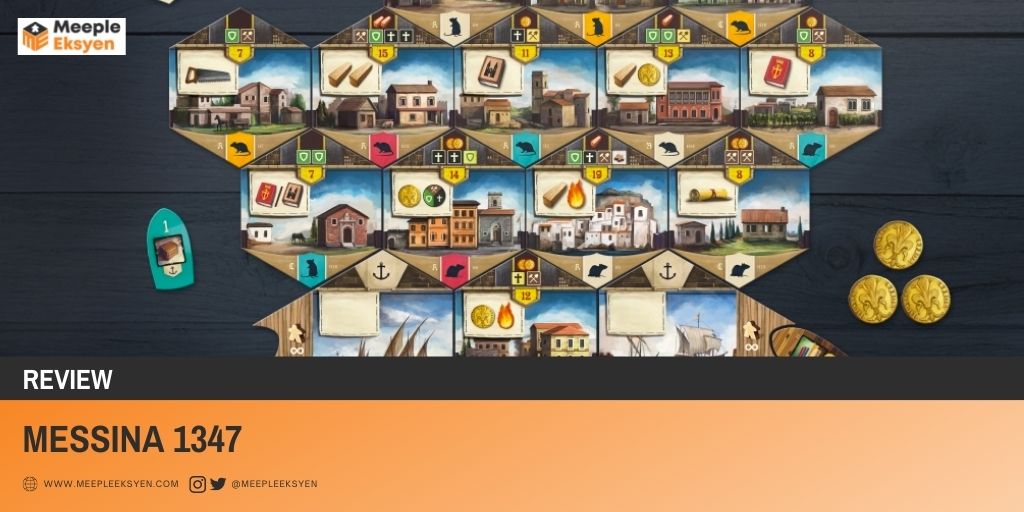If the humanity in this modern era has come up against the 2022 COVID-19 outbreak, the Middle Age Europeans have already experienced the similar, or maybe more horrifying adversity before us. It was 1347 when the grim bubonic plague struck Europe for the first time. Twelve ships have made it to the Sicilian port of Messina, but sadly not its sailors — most of them were either dead or gravely ill, covered with black boils. This uninviting calamity becomes the basis premise for Messina 1347’s background story.
Messina 1347 is a medium-to-heavy weight euro game, a new piece from the duo Raúl Fernández Aparicio and Vladimír Suchý. This game has been staying in our backlog list since the twilight of SPIEL Messe 2021, and here we are trying our best to shorten that register while getting piled up with many more interesting games. I have to admit, I was lucky I still got the game on Day Two. If you saw the rate Delicious Games sold those copies per minute, you would understand me — it was a hot game, might get sold out rapidly just like the delicious bagels, freshly taken out from the oven.
A short disclaimer before you read my board game analysis
As an avid euro gamer and hardcore Legend of the Five Rings (L5R) LCG player, my reviews may reflect a preference for these styles, and I may not cover solo games/variants extensively. Please note that my personal remarks are based on my gaming experiences, and I aim to provide honest insights within the scope of my preferences.
You will find some gameplay explanations in this article that made me pause in admiration every here and then. If you are looking for more detailed tutorials, there are a few good videos on YouTube. Without further ado, let’s unravel why this game was so hype — and whether it deserved the spotlight at Hall 6 in 2021.
A glance before facing the calamity
With the pandemic still goes on affecting lives across the globe, the approach taken by the design team to incorporate such an equivalent theme is intriguing. Well, some players may without any doubt find it interesting and related to what’s currently happening; the rest, however, might draw their eyebrows close together, thanks to the appalling premise of an event that eradicated one-third of the European population in that era.
As you can imagine, it is neither exactly a good bedtime story nor an exciting tale for a game. But nevertheless, the premise, for me, is promising, despite being used multiple times by many precursory games. It would be fascinating to find out how they adhered this background story with the mechanic and overall gameplay.
I’ve read and heard some bad publicity regarding Delicious Games’ production quality. Some reviewer peers have mentioned the sub-par calibre from their previous project if compared to their Rio Grande Games’ counterpart. That gave me pure chill, actually, knowing that there was a slight chance that I have purchased a game with low-quality components. Anyway, it got worse as they distributed a sticker to be pasted on a mistake in the rulebook — my impression on Messina 1347 had a rough start.
Funnily, my curiosity level didn’t budge nonetheless — my inner self still pushed me to get into the line that day. My head guided my hands to pick out my wallet and pay for Messina 1347 when I reached the cashier. Otherwise, I would not have written this review here.
Unboxing MESSINA 1347
For some reason, the artwork produces a quite colourful sense. It didn’t radiate that miserable vibe, coming from a game that brings up the blight that ruined not only an entire nation, but the whole continent. This kind of misplacement is not disturbing in any way, though. In fact, the misfit seems to fit perfectly for the depiction of a beautiful city fighting for its survival against the incoming rampant.
My worry over the production quality was for nought, actually — after I saw the thick player and main boards, and also some components within, I let out a big breath of relief. Messina 1347 does not come with a set of glorified deluxe components, and it stays humble, just like typical euro games out there. As I said before, the boards are made of thick papers — they are sturdier than I imagine. At this point, I have no complaints at all.
CRISIS MANAGEMENT 101 — WHAT WE LIKE FROM MESSINA 1347
The city, Messina, is depicted in several hexes surrounded by four docks on each corner. As the member of a royal family, we will order our lieutenants around — they will scavenge for resources or execute actions in the forsaken port town and then rescue as many citizens within that space. Of course, you cannot miss the classic worker placement mechanic implemented in this part.
During the six rounds, these lieutenants can move to an adjacent hex for free, but travelling beyond that can be costly. You need to reach deeper into your pocket when ordering them to move even further. That gives another perspective in an already strategic game — sending your lieutenant to a distant hex may bring some resources you need, but is it worth the Coins?
Anyway, if that hex your lieutenant currently visiting is plagued, by using Fire, they may cleanse that space before escorting the potentially infected people to safety and reap the advantages from that space. These citizens need to stay in the quarantine quarter for two turns. When the hex is actually free from the infection, they can directly join the general population in the refugee centre, where they can contribute when your Overseer advances on certain spaces; or to the workshops to start working and generating resources for you.
Speaking of resources, Fire tokens secure the top spot in the to-have priority list. One of the three Registers in Messina 1347 (the Popularity track) can only be advanced by eradicating the plague. Only this Fire resource enables the cleansing, and all players will really fight for it. It is limitedly available in the open hex — starting from the fifth round, the requirement to remove the plague is doubled. Actually, we can ignore the plague and just rescue the citizen and take the next action/resource there. However, it brings a dire consequence: a Rat token will come with you to your district, and enough Rats impose penance in the form of point deductions at the end of the game.
Messina 1347 offers an optimization path for the quarantine quarter: with an upgrade, we can provide smaller workshops within the isolation area. That means they don’t stay idle in those two turns and can contribute to the society. Letting them sit for one third of the game would be a waste, right?
THINGS THAT DON’T SUIT US, PERSONALLY
With many things moving around on the board, I was expecting more diverse ways to win the game. Besides advancing the Registers to earn more Victory Points (VP), there are three additional point multipliers we can foster: for each workshop, ship, and repopulated hex. Nevertheless, in most of our games, especially one of that multipliers steals the spotlight — the workshop.
Taking a look back to the ships, the rewards are not mouth-watering at all. We rarely order our lieutenants to visit the dock and the anchoring ships, simply because the rewards are pretty underwhelming. I wouldn’t waste my move AND a Fire token just to earn insipid compensation. Comparing the same move on another hex, I can reap the reward, advance Popularity track, and rescue some folks into my quarter.
Unfortunately, the story repeats itself with the repopulating case as well. I have to admit, the exquisite coupling between this mechanic and the background story is top-notch, and I like it. Despite how moving it is, I am quite indifferent with the execution during the gameplay.
Let’s do the maths here: To repopulate, we are trading some resources AND some required citizens — they will leave your quarter, rebuilding the then-plagued hex, and moving on with their lives (read: coming back to the general pool).
It’s true, we still get rewarded with handsome VP at the end of the game, and additional VP whenever another player utilizes that revamped hex. Nevertheless, it is against our best interest to spend the resources for repopulating so early in the game. You will have fewer people in the quarter and workshops to do the job. Having them in the late game makes more sense, but they don’t really bring adequate VP from other players’ utilization to justify the expenditure here.
From this point-of-view, it is understandable when we spend the rest of the game to build as many workshops as possible — and meanwhile, optimize this specific multiplier on the run.
verdict
At this point, you can get the big picture: Messina 1347 is not a light game. It is meaty, and it needs you to weigh and make tough decisions. There are many things, happening across the board, and you have to keep them all in-check. Resources are scarce, and we are fighting among us to get our hands into it. We only have six rounds to make ends meet (read: getting as much VP as possible). There is nothing complete new in this game — it utilizes the typical worker placement found in most euro games out there. But what’s really new under the sun nowadays? Messina 1347 has proven to deliver a nice game despite its drawbacks I mentioned before. It may not be that cup of tea for every gamer out there, but I think you will like it at the end of the day.
Do you love board games as much as we do? Support us!
Thank you for reading our articles! If you enjoyed our work and want more captivating board game contents, make sure to:
👉 Follow us on our social media — you can find us on ![]()
![]()
![]() Click one of the icons to land on our social media, or find us @meepleeksyen there, it’s just a click away! Stay updated with our latest board game reviews and previews by following us on those platforms 📱👍
Click one of the icons to land on our social media, or find us @meepleeksyen there, it’s just a click away! Stay updated with our latest board game reviews and previews by following us on those platforms 📱👍
💬 Do you have contrasting opinions? Leave a comment — share your thoughts with us, we’d love to hear (or read) yours! Have you played this game before? Did you have something similar as well? Or perhaps, something more personal, like what are your favourite board games? Let’s discuss in the comments below!
🙏 Support Us! Your generous support can help us produce even better content in the future. If you love what we do, consider making a donation to our blog. Every contribution counts and means a lot to us! You can either donate locally with Indonesian Rupiah (IDR) via Trakteer ![]() or for international readers with another currency through Buy Me a Coffee
or for international readers with another currency through Buy Me a Coffee ![]() It helps us to survive, too! 💰 Click one of the button below 👇
It helps us to survive, too! 💰 Click one of the button below 👇
I am a full-time food technologist during weekdays. However, when the calendar hits weekends, I transform into an avid board gamer. I am a hardcore Legend of the Five Rings (L5R) LCG player from Fantasy Flight Games (FFG). Current hobby: buying board games. My shelf of shame’s list is getting longer, thanks to you, Kickstarter.





